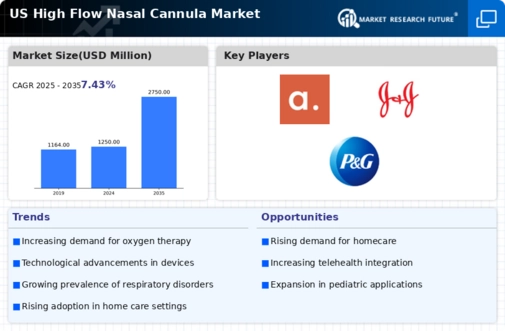Rising Prevalence of Respiratory Disorders
The increasing incidence of respiratory disorders in the US is a primary driver for the high flow-nasal-cannula market. Conditions such as chronic obstructive pulmonary disease (COPD), asthma, and pneumonia are becoming more prevalent, necessitating advanced respiratory support solutions. According to recent data, approximately 16 million Americans are diagnosed with COPD, and millions more suffer from undiagnosed conditions. This growing patient population is likely to drive demand for high flow-nasal-cannula systems, which provide effective oxygen therapy. The high flow-nasal-cannula market is expected to benefit from this trend, as healthcare providers seek to improve patient outcomes through innovative respiratory therapies.
Growing Focus on Emergency Medical Services
The emphasis on enhancing emergency medical services (EMS) in the US is a crucial driver for the high flow-nasal-cannula market. As emergency departments strive to improve patient care during critical situations, the demand for effective oxygen delivery systems is rising. High flow-nasal-cannula devices are increasingly recognized for their ability to provide rapid and efficient oxygenation, which is vital in emergency scenarios. The high flow-nasal-cannula market is poised to expand as EMS providers incorporate these systems into their protocols, ensuring better patient outcomes in acute care settings. This trend may lead to increased investments in training and equipment for EMS personnel.
Technological Innovations in Respiratory Care
Technological advancements in respiratory care equipment are significantly influencing the high flow-nasal-cannula market. Innovations such as improved flow rate capabilities, enhanced humidification systems, and integrated monitoring features are making high flow-nasal-cannula devices more effective and user-friendly. The market is witnessing a shift towards devices that offer real-time data analytics and connectivity, allowing healthcare professionals to monitor patients remotely. This trend is expected to enhance the efficiency of respiratory care, potentially increasing the adoption of high flow-nasal-cannula systems in clinical settings. The high flow-nasal-cannula market is likely to see substantial growth as these technologies become more prevalent.
Increased Investment in Healthcare Infrastructure
The ongoing investment in healthcare infrastructure across the US is a significant driver for the high flow-nasal-cannula market. As hospitals and healthcare facilities expand and upgrade their capabilities, there is a growing need for advanced respiratory care technologies. This investment is likely to enhance the availability and accessibility of high flow-nasal-cannula systems, particularly in underserved areas. The high flow-nasal-cannula market stands to benefit from these developments, as healthcare providers seek to equip their facilities with state-of-the-art equipment to meet the rising demand for respiratory therapies. This trend may also lead to increased competition among manufacturers, further driving innovation.
Shift Towards Non-Invasive Ventilation Techniques
The trend towards non-invasive ventilation techniques is reshaping the high flow-nasal-cannula market. Healthcare providers are increasingly favoring non-invasive methods to manage respiratory failure and improve patient comfort. High flow-nasal-cannula systems are gaining traction as they offer a less invasive alternative to traditional mechanical ventilation, reducing the risk of complications associated with intubation. This shift is likely to drive the adoption of high flow-nasal-cannula devices in both hospital and home care settings. The high flow-nasal-cannula market is expected to grow as more clinicians recognize the benefits of non-invasive approaches in respiratory management.














Leave a Comment